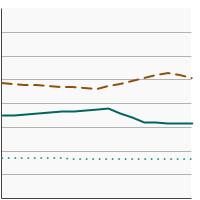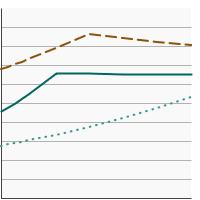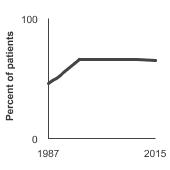On This Page:
Background
Breast cancer is the most common type of cancer among women in the United States (other than skin cancer). Women with breast cancer have many treatment options, including surgery, radiation therapy, hormone therapy, chemotherapy, immunotherapy, and targeted therapy. Treatment options for a woman diagnosed with breast cancer may include more than one type of treatment (ex. Surgery and radiation) or more than one agent (multi-agent chemotherapy).
The proportion of women with node-positive disease (cancer in the lymph nodes near the tumor) receiving guideline-concordant treatment is high. Clinical trials have demonstrated that women with early stage breast cancer who receive breast-conserving surgery (BCS) with radiation therapy have a survival rate similar to those of women who undergo a mastectomy. Among women for whom chemotherapy is indicated, older women are less likely to receive chemotherapy than younger women, but there are no major differences in treatment among major racial and ethnic groups.
Breast cancer also develops in men, but it is rare and is not included in the data presented on this page.
Measure
Percentage of women aged 20 and older, diagnosed with early stage breast cancer (stage I or II), receiving breast-conserving surgery and radiation treatment.
Percentage of women aged 20 and older, diagnosed with node-positive, stage I–IIIA breast cancer, receiving multi-agent chemotherapy.
Note: This measure includes women with both hormone receptor positive and negative breast cancer.
Data Source
Breast-conserving surgery and radiation treatment estimates: SEER 17 Registries, National Cancer Institute, 2004–2019.
Multi-agent chemotherapy estimates: SEER Patterns of Care/Quality of Care Studies, National Cancer Institute, 1987-2015.
Healthy People 2030 Target
- There are no Healthy People 2030 targets for cancer treatment, including breast cancer treatment and multi-agent chemotherapy.
Healthy People 2030 is a set of goals set forth by the Department of Health and Human Services.
Trends and Most Recent Estimates
Treatment Distribution
| Overview Graph | Detailed Trend Graphs | Most Recent Estimates (2020) | |
|---|---|---|---|
| Percent of patients | 95% Confidence Interval | ||
  |
Mastectomy |
31.8 | 31.7 - 32.0 |
BCS with radiation |
50.4 | 50.2 - 50.6 | |
BCS without radiation |
17.7 | 17.6 - 17.9 | |
Chemotherapy
| Overview Graph | Detailed Trend Graphs | Most Recent Estimates (2015) | |
|---|---|---|---|
| Percent of patients | 95% Confidence Interval | ||
  |
Ages 20+ |
64.2 | 57.6 - 70.2 |
Ages 20-64 |
82.4 | 74.6 - 88.2 | |
Ages 65+ |
40.7 | 29.9 - 52.5 | |
Additional Information
- Breast Cancer. National Cancer Institute.
- Breast Cancer Treatment (PDQ®)-Patient Version. National Cancer Institute.
- Breast Biopsy. American Cancer Society.
- Treating Breast Cancer. American Cancer Society.
- Breast Cancer (NCCN Guidelines for Patients®). National Comprehensive Cancer Network.
- Advances in Breast Cancer Research. National Cancer Institute.
- Breast Cancer Treatment (PDQ®)-Health Professional Version. National Cancer Institute.
- SEER Cancer Stat Facts: Breast Cancer. National Cancer Institute.
- SEER-Medicare Linked Database. National Cancer Institute.
- SEER Patterns of Care/Quality of Care Studies. National Cancer Institute.
